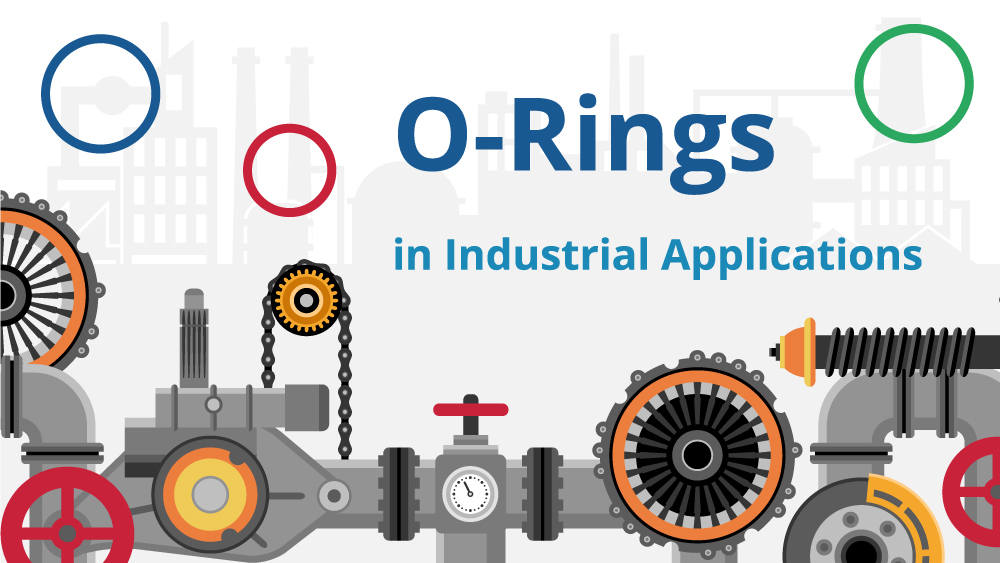
Summary
- O-Rings are crucial yet often overlooked components, vital for various industries, including automotive, aerospace, and oil & gas, due to their sealing properties.
- The material and size selection of o-rings is critical for specific industrial applications and contributes to operational efficiency, safety, and cost-effectiveness.
- Global O-Ring and Seal specializes in providing high-quality o-rings, contributing to the smooth running of numerous industrial operations worldwide.
Introduction
In the world of industrial machinery, our attention often gravitates toward complex systems like intricate gears, advanced circuits, and high-tech control systems. Indeed, these elements are vital, but the success and efficiency of an industrial unit often hinge on simpler components, like o-rings. At Global O-Ring and Seal, we have always focused on these integral yet frequently overlooked components, acknowledging their pivotal role across numerous sectors. This comprehensive guide aims to deepen your understanding of the importance, usage, benefits, and selection of o-rings in the industrial landscape.
The Role of Industrial O-Rings
O-Rings might seem simple, but they serve an incredibly crucial function. Essentially, an o-ring is a loop of elastomer characterized by a round, or “o”-shaped, cross-section. It’s designed to be seated in a groove and compressed during assembly between two or more parts, creating a seal at the interface. This seemingly simple design, achieved through careful engineering, enables o-rings to withstand challenging environments, enduring harsh chemicals, extreme temperatures, and high pressures.
The structure of an o-ring is simple yet ingenious. Its round cross-section and the deformation it undergoes when compressed enables it to form an excellent seal, preventing gases or liquids from escaping. Let’s delve into the multifaceted significance of these sealing stalwarts.
O-Rings: The Heroes of Industrial Applications
O-Rings, though often hidden deep within the heart of machines, play an indispensable role in many industrial applications. Their primary function is to prevent the escape of gases or fluids, thus maintaining the integrity and operational efficiency of the systems they are part of.
Without o-rings, many industrial systems we rely on daily would fail. For instance, imagine a submarine grappling with high-pressure system failures or air conditioning units prone to refrigerant leaks. Worse yet, consider the catastrophic impact of a combustion engine failing due to improper sealing.
In each case, the robust and reliable o-rings stand guard, ensuring safe and efficient operation. Furthermore, o-rings also significantly contribute to industrial productivity. Any time lost due to leaks or malfunctions can cause substantial disruptions to output and performance. Therefore, the humble o-rings are the unsung heroes, forming the bedrock of efficient and uninterrupted operations in diverse industrial settings.
The Versatility of O-Rings Across Industries

The versatility of o-rings is second to none. Their wide range of applications is a testament to their adaptability, resilience, and enduring utility. Each industry has a unique set of operational conditions, regulatory standards, and performance requirements, all of which influence the design, selection, and application of o-rings.
The automotive industry, for instance, is replete with applications for o-rings. These range from fuel injection systems and air conditioning units to brake cylinders and power steering systems. A single vehicle can house hundreds of o-rings, each performing a vital role in the vehicle’s smooth operation. For more information on how o-rings serve the automotive industry, follow this link to our Automotive o-rings page.
In the aerospace industry, the stakes are even higher. Hydraulic systems, fuel lines, and engine components all rely on the resilience and durability of o-rings to perform under extreme pressures and temperatures. Moreover, these o-rings are often subject to some of the most stringent industry and governmental standards. To read further on how o-rings are used in the aerospace industry and the standards that must be met for these parts, view our Military and Aerospace page.
The medical industry is another key sector where o-rings are extensively utilized. In this field, o-rings are incorporated into surgical instruments, drug-delivery devices, and implants. These o-rings must be biocompatible, able to withstand sterilization processes, and provide unfailing reliability over extended periods. Visit our Medical & Pharmaceutical page for more information on common o-rings used in this industry and a list of o-rings we supply in USP Class VI material.
Finally, the oil & gas industry is known for placing heavy demands on equipment, including o-rings. These are often exposed to a challenging blend of high-pressure and high-temperature conditions, not to mention the corrosive effects of petroleum and gas. O-Rings employed in this sector must withstand these harsh conditions, often over extended periods, to ensure system safety and operational efficiency. For more information on how various o-rings serve the oil & gas industry and recommendations for their suitability in upstream, midstream, and downstream applications, visit our Oil & Gas Sealing Products page.
These examples underscore the adaptability of o-rings, their critical role in varied industries, and the challenges they must overcome, but this list of industries is just the beginning. O-Rings are also found in the following industries: food and beverage, agriculture, water filtration, manufacturing, semiconductor, and many more.

Harvesting the Benefits of High-Quality O-Rings
Investing in high-quality o-rings, like those offered by Global O-Ring and Seal, offers significant benefits. These advantages directly affect an organization’s operational efficiency, maintenance expenses, and overall safety.
High-quality o-rings dramatically reduce maintenance costs. Lower-quality seals can lead to leaks and equipment failure, escalating repair and replacement costs. Conversely, investing in high-quality o-rings helps to minimize these unexpected expenses and reduce overall maintenance needs.
Next, high-quality o-rings boost operational efficiency. A dependable o-ring ensures smooth machine operation, minimizing the risk of unforeseen breakdowns. The heightened performance leads to improved productivity and an extended lifespan for the equipment.
Finally, and perhaps most importantly, o-rings are essential in guaranteeing safety. Defective seals can result in leaks or equipment failures that pose significant risks to operational safety and personnel welfare. Opting for high-quality o-rings is critical to maintaining a secure working environment.
Choosing the Right O-Ring Material
Selecting the correct o-ring isn’t only about finding the right size and shape. The material from which the o-ring is made is equally critical. Each type boasts unique properties, making it suitable for certain applications. Further, the industry in which the o-ring will be used widely influences the choice of material.
Buna (Nitrile) o-rings are used widely due to their excellent resistance to oils and petroleum-based fluids. These o-rings also demonstrate remarkable resistance to wear and tear and can withstand a broad range of temperatures. This versatility makes them ideal for various industrial applications, including automotive and manufacturing sectors, where oil and fuel resistance is paramount. Learn more about nitrile o-rings.
Viton (FKM) o-rings are the go-to choice for applications requiring resistance to high temperatures and a wide array of chemicals, oils, and fuels. This impressive chemical resistance makes Viton o-rings a preferred choice in sectors like automotive, aerospace, and oil and gas, where they frequently come into contact with aggressive substances. Click here for more information on Viton o-rings.
Silicone o-rings are appreciated for their flexibility and resistance to various oils and solvents. They are food-safe, making them an excellent choice for the food and beverage industry. Their superior resistance to extreme temperatures ensures their performance, even in challenging conditions. For more information, visit our Silicone o-rings page.
Teflon o-rings stand apart when it comes to resistance to chemicals and temperatures. They are generally used in applications involving harsh chemical environments or those requiring a broad temperature range. Their inert nature makes them compatible with almost all industrial chemicals, making them the material of choice for many critical applications, particularly in the chemical industry. Learn more on Teflon (PTFE) o-rings.
For a full list of Global O-Rings compounds and their properties, visit our compounds page and interactive chemical compatibility tool.
O-Ring Sizes: The Key to a Perfect Fit
The size of an o-ring plays a pivotal role in ensuring an effective seal. An undersized o-ring might lead to leaks, while an oversized one may not fit into the designated groove. Understanding o-ring sizes is thus crucial when selecting these components.
Standard sizing systems exist for o-rings, such as the AS568 standard for Aerospace Size Standard o-rings, offering a uniform classification system for o-rings with different inside diameters and cross-sections. To view the full AS568 size chart, click here.
The metric o-ring size system, widely used globally across various industries, follows the international standard ISO 3601. The two measurements provided are the internal diameter (ID) and the cross-sectional diameter (CS).
O-Ring cord stock, an extruded cord with an o-ring profile, offers a versatile solution for applications requiring custom-sized seals. These cords can be cut to the desired length and vulcanized to form a custom-sized o-ring. This flexibility makes it ideal for a wide array of applications. For more information on Global O-Ring’s vulcanization process, follow this link.
Future Trends in O-Ring Technologies
O-Ring technology continues to evolve alongside the ever-changing industrial demands and technological advancements. One such evolution is the development of new o-ring materials spurred by improvements in material science. These new materials offer improved performance, greater wear resistance, and enhanced flexibility over a wide temperature range, paving the way for o-rings to be utilized in even more diverse applications
Conclusion: The Unwavering Relevance of O-Rings
In the complex world of industrial machinery and equipment, it’s easy to overlook seemingly insignificant parts. However, as we have explored, o-rings play an integral role across many industries. With advancing technology and ever-tightening industry standards, the importance of these simple components will only continue to grow.
For an industry to stay ahead of the curve and ensure the smooth operation of its systems, a reliable supplier is a must. You can trust Global O-Ring and Seal to provide high-quality o-rings that meet your specific needs and keep your operations running smoothly.
Their continued relevance, adaptability, and cost-effectiveness ensure that o-rings will continue to find their place in the machinery of the future. Even as we look ahead, the importance of these critical components remains. This reliability and dependability are why we have dedicated ourselves to the supply of high-quality o-rings, Backup Rings, X-Rings, Cord Stock, and related seals to industries worldwide. We understand their significance and are committed to delivering excellence to ensure your operations run as smoothly as possible.
Though small and often unnoticed, o-rings are truly the unsung heroes of the industrial world. Their role is as vital as it is versatile, serving industries from automotive to oil & gas and everything in between. So, the next time you marvel at the wonders of industrial machinery, spare a thought for the humble o-ring, quietly doing its job and holding our world together.

 English
English  Español
Español  Français
Français  Português
Português  Deutsch
Deutsch  Italiano
Italiano  Русский
Русский  中文
中文  日本語
日本語  العربية
العربية  हिन्दी
हिन्दी 



